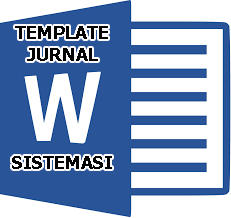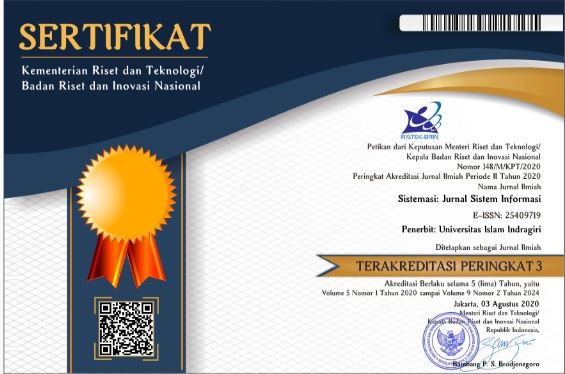Deteksi Phishing Website Menggunakan Machine Learning Metode Klasifikasi
Abstract
Full Text:
PDFReferences
APJII, “APJII (Indonesia Association Internet Services Organizer) report on 2019-2020 [Q2]”, Jul. 2020. https://www.infotek.id/licenses/survey_apjii_2020/Survei_APJII_2019-2020_Q2.pdf [Diakses pada 9 Juli 2023].
APWG, “APWG (Anti-Phishing Working Group) Phishing Activity Trends Report”, 1st Quarter 2021. https://docs.apwg.org/reports/apwg_trends_report_q1_2021.pdf [Diakses pada 9 Juli 2023].
R. Putra Ramadhan and T. Desyani, “Implementasi Algoritma J48 untuk Identifikasi Website Phishing”, Biner, vol. 1, no. 2, pp. 46–54, Jun. 2023.
Grand View Research, “Cyber Security Market Size and Share | Industry Report, 2019-2025,” Grandviewresearch.com, 2019. https://www.grandviewresearch.com/industry-analysis/cyber-security-market [Diakses pada 10 Juli 2023].
S. Badillo et al., “An Introduction to Machine Learning,” Clinical Pharmacology & Therapeutics, vol. 107, no. 4, pp. 871–885, Mar. 2020, doi: https://doi.org/10.1002/cpt.1796.
A. K. Jain and B. B. Gupta, “A machine learning based approach for phishing detection using hyperlinks information,” Journal of Ambient Intelligence and Humanized Computing, vol. 10, no. 5, pp. 2015–2028, Apr. 2018, doi: https://doi.org/10.1007/s12652-018-0798-z.
M. Korkmaz, O. K. Sahingoz, and B. Diri, “Detection of Phishing Websites by Using Machine Learning-Based URL Analysis,” 2020 11th International Conference on Computing, Communication and Networking Technologies (ICCCNT), Jul. 2020, doi: https://doi.org/10.1109/icccnt49239.2020.9225561.
M. Abutaha, M. Ababneh, K. A. Mahmoud, and Sherenaz W. Al-Haj Baddar, “URL Phishing Detection using Machine Learning Techniques based on URLs Lexical Analysis,” 2021 12th International Conference on Information and Communication Systems (ICICS), May 2021, doi: https://doi.org/10.1109/icics52457.2021.9464539.
O. K. Sahingoz, E. Buber, O. Demir, and B. Diri, “Machine learning based phishing detection from URLs,” Expert Systems with Applications, vol. 117, pp. 345–357, Mar. 2019, doi: https://doi.org/10.1016/j.eswa.2018.09.029.
A. Safi and S. Singh, “A systematic literature review on phishing website detection techniques,” Journal of King Saud University - Computer and Information Sciences, Jan. 2023, doi: https://doi.org/10.1016/j.jksuci.2023.01.004.
S. Shabudin, N. Samsiah, K. Akram, and M. Aliff, “Feature Selection for Phishing Website Classification,” International Journal of Advanced Computer Science and Applications, vol. 11, no. 4, 2020, doi: https://doi.org/10.14569/ijacsa.2020.0110477.
M. Hasnain, M. F. Pasha, I. Ghani, M. Imran, M. Y. Alzahrani, and R. Budiarto, “Evaluating Trust Prediction and Confusion Matrix Measures for Web Services Ranking,” IEEE Access, vol. 8, pp. 90847–90861, 2020, doi: https://doi.org/10.1109/access.2020.2994222.
F. Rahmad, Y. Suryanto, and K. Ramli, “Performance Comparison of Anti-Spam Technology Using Confusion Matrix Classification,” IOP Conference Series: Materials Science and Engineering, vol. 879, p. 012076, Aug. 2020, doi: https://doi.org/10.1088/1757-899x/879/1/012076.
J. A. Mat Jizat, A. P.P. Abdul Majeed, A. F. Ab. Nasir, Z. Taha, and E. Yuen, “Evaluation of the machine learning classifier in wafer defects classification,” ICT Express, May 2021, doi: https://doi.org/10.1016/j.icte.2021.04.007.
I. Muraina, “Ideal dataset splitting ratios in machine learning algorithms: general concerns for data scientists and data analysts”, 7th International Mardin Artuklu Scientific Research Conference, pp. 496-504, Feb. 2022.
DOI: https://doi.org/10.32520/stmsi.v13i4.3456
Article Metrics
Abstract view : 2919 timesPDF - 1516 times
Refbacks
- There are currently no refbacks.

This work is licensed under a Creative Commons Attribution-ShareAlike 4.0 International License.









